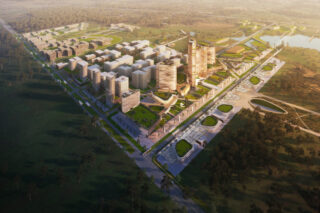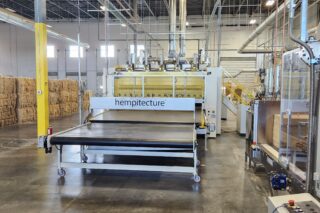Incredible as it may seem, runoff from heavy rainstorms and melting snow is one of the biggest environmental threats facing many cities today. A heavy rainstorm typically washes oils, sediment and other contaminants from sidewalks and streets into sewer systems and waterways. Not only is stormwater runoff a danger to drinking water supplies, but it also has the potential to transform harbors and rivers into slimy soups topped with floating dead fish. Indeed, in some cities in developing countries, unfiltered stormwater has helped create atrophied bodies of water that give off toxic fumes and serve as breeding grounds for insects that spread pestilence.
 In the developed world, some municipalities have spent billions of dollars of money on so-called gray infrastructures, such as combined stormwater and sewage treatment plants. But now some enlightened cities are installing green stormwater infrastructure, which can include green roofs, planted plazas and tree-lined streets designed to capture stormwater and recycle it for plant irrigation. New York City is one of the trailblazers with an ambitious $2.4 billion green infrastructure plan as well as a number of privately funded projects that feature innovative approaches.
In the developed world, some municipalities have spent billions of dollars of money on so-called gray infrastructures, such as combined stormwater and sewage treatment plants. But now some enlightened cities are installing green stormwater infrastructure, which can include green roofs, planted plazas and tree-lined streets designed to capture stormwater and recycle it for plant irrigation. New York City is one of the trailblazers with an ambitious $2.4 billion green infrastructure plan as well as a number of privately funded projects that feature innovative approaches.
 It can be challenging to incorporate Mother Nature into paved streetscapes in such a way that she flourishes and that a significant amount of stormwater can be captured. “If you go look at a street tree in New York City, you see the hole it is growing out of but everything underneath that pavement around the hole is compacted,” says Doug Findlay, managing partner in PWP Landscape Architecture, adding, “When the soil compacts it squishes all the pores out and you don’t get any air and water in there, and when that happens the tree is finished.”
It can be challenging to incorporate Mother Nature into paved streetscapes in such a way that she flourishes and that a significant amount of stormwater can be captured. “If you go look at a street tree in New York City, you see the hole it is growing out of but everything underneath that pavement around the hole is compacted,” says Doug Findlay, managing partner in PWP Landscape Architecture, adding, “When the soil compacts it squishes all the pores out and you don’t get any air and water in there, and when that happens the tree is finished.”
Findlay’s firm designed the recently completed 9/11 Memorial plaza, which captures virtually all the stormwater that is not immediately consumed by the trees and patches of lawn. Beneath the plaza is a specially designed drainage system consisting of a waffled line of drains and an underground network of pipes that directs the excess stormwater runoff into two enormous cisterns situated seven stories below the plaza, from where it is pumped back up to irrigate the landscape in times of need.
As opposed to the compressible planting soil that surrounds a typical New York City street tree pit, the 9/11 Memorial plaza is suspended on structural soil, a patented mixture of gravel and clay loam, which was developed at Cornell University in the 1990s and is marketed under the name Structural Soil. According to Findlay, the inherent permeability of structural soil enables stormwater to drain, and at the same time, it provides a surface firm enough to resist compression. Largely due to the special drainage system at the 9/11 Memorial plaza, the swamp white oaks planted there are expected to live an estimated 80 years as opposed to the 10-year lifespan of the average New York City street tree.
North Court, by its original name, at New York City’s Lincoln Center for the Performing Arts is another famous plaza that features state-of-the-art stormwater technology. Originally designed by renowned landscape architect Dan Kiley, North Court had to be redesigned in 2005 because of a poor drainage system that left puddles on the plaza and also because its bosques of the trees were prematurely dying because they had been placed in raised concrete planters that didn’t allow their roots enough space to expand.
 In order to improve the ecology of North Court, now Hearst plaza, a new bosque of trees was planted directly into the ground cover using a modular system called Silva Cell. A more expensive alternative to structural soil, Silva Cell protects large amounts of soil from being compacted with a cellular-like support structure that is situated beneath the ground. “You use it in a situation where there is constant high traffic over-tree root mass or in places where you are using pavement and trying to protect the soils underneath from compaction,” says Signe Nielsen, a principal in Mathews Nielsen Landscape Architects, which was part of the North Court’s redesign team.
In order to improve the ecology of North Court, now Hearst plaza, a new bosque of trees was planted directly into the ground cover using a modular system called Silva Cell. A more expensive alternative to structural soil, Silva Cell protects large amounts of soil from being compacted with a cellular-like support structure that is situated beneath the ground. “You use it in a situation where there is constant high traffic over-tree root mass or in places where you are using pavement and trying to protect the soils underneath from compaction,” says Signe Nielsen, a principal in Mathews Nielsen Landscape Architects, which was part of the North Court’s redesign team.
Advances in porous paving materials also offer a means for controlling stormwater and for providing better irrigation of plants. These products, which are made by a variety of companies, can include permeable pavers with porous borders that allow stormwater to seep through the soil underneath as well as porous concrete, porous asphalt that has permeable interconnected voids.
 Permeable pavers and other porous materials are still controversial with many city agencies because they require constant maintenance and cleaning to retain their porosity, and that can be a challenge in a heavily trafficked urban environment. “Over time permeable asphalt and permeable concrete clog up,” says Eric Rothstein, managing partner in eDesign Dynamics, an environmental engineering firm specializing in low-impact water resources planning.
Permeable pavers and other porous materials are still controversial with many city agencies because they require constant maintenance and cleaning to retain their porosity, and that can be a challenge in a heavily trafficked urban environment. “Over time permeable asphalt and permeable concrete clog up,” says Eric Rothstein, managing partner in eDesign Dynamics, an environmental engineering firm specializing in low-impact water resources planning.
However, Rothstein says that a new product called Stormcrete has the potential to significantly reduce the maintenance burdens associated with permeable paving materials. Stormcrete comes in precast porous concrete slabs, which can be lifted up by a tractor and vacuum cleaned to ensure that it retains its permeability.
Rothstein also says that several notable stormwater products on the market include water quality devices such as Vortechs and Stormsceptor Systems, which can be installed in drains. Both of these devices use centrifugal force to separate out sediment, oil and other roadway pollutants.
Despite the recent advances, in some places, particularly pedestrian plazas, innovative design solutions can supplant the need for expensive new stormwater technologies. At the 9/11 Memorial for example, most of the stormwater capture system is composed of concrete, plastic pipe, and fittings, says Findlay, adding, “It is the ingenuity of it, it is the inventiveness, [the 9/11 Memorial] doesn’t have fancy equipment at all.”











